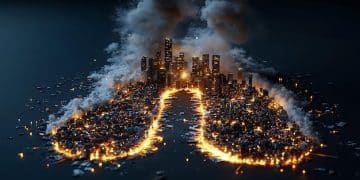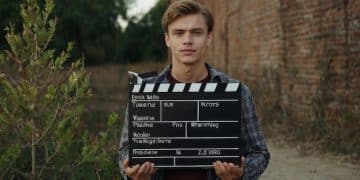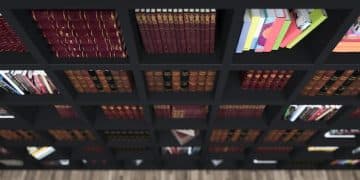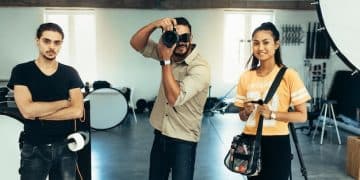Short Film Production Design: Believable Worlds on a Small Scale in the US
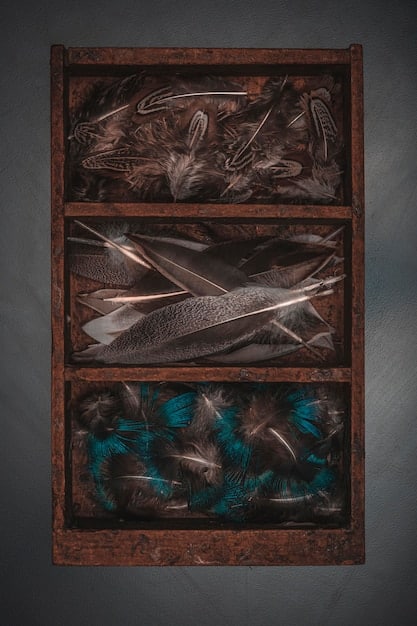
Short film production design in the U.S. involves crafting immersive and credible worlds within limited budgets, demanding resourceful creativity from set design, props, costumes, and locations to enhance storytelling.
Crafting a convincing world in a short film with limited resources can seem daunting, but smart short film production design: creating believable worlds on a small scale in the US, allows filmmakers to transport audiences to another reality, making their stories truly memorable.
Understanding the Core Principles of Short Film Production Design
Production design is the visual heart of any film, big or small. For short films, it becomes even more crucial as it sets the stage, literally and figuratively, and quickly immerses the audience in the narrative.
It’s about strategically curating visual elements to support the story, evoke specific emotions, and communicate the film’s themes effectively, all while working within budget constraints.
Storytelling Through Visuals
Effective production design does more than just look good; it tells a story. Each element, from the color palette to the chosen props, should contribute to the narrative’s depth.
Consider how the environment reflects the characters’ inner states or foreshadows upcoming events. For example, a cluttered, dimly lit room might indicate a character’s troubled mind, while a bright, airy space could signify hope or freedom.
Budget-Conscious Creativity
Short film budgets are often tight, so resourcefulness is key. This doesn’t mean sacrificing quality but rather thinking creatively about how to achieve the desired look without breaking the bank.
This may involve repurposing existing locations, creating DIY props, or leveraging the skills of passionate volunteers. The challenge lies in making every dollar count and maximizing the impact of each visual element.
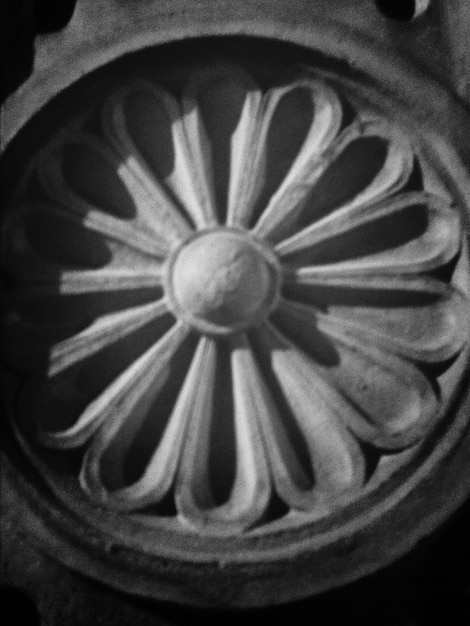
Smart planning and a keen eye for detail can make a small investment look like a million bucks.
- Prioritize Visual Storytelling: Focus on elements that directly support the narrative.
- Embrace DIY: Get creative with homemade props and set decorations.
- Optimize Locations: Choose locations that offer the most production value for the cost.
- Collaborate Cleverly: Build a team that is willing to work together to share resources.
Ultimately, the core principles are about making informed choices that amplify the narrative impact within the constraints of a limited budget.
Location Scouting and Management for Short Films
Selecting the right location can significantly elevate a short film’s production value. Location scouting involves more than just finding a visually appealing spot; it requires logistical planning and creative problem-solving.
Carefully chosen locations can enhance the storytelling process and minimize the need for extensive set construction, saving time and money.
Finding the Perfect Spot
Start by identifying locations that align with the script’s requirements. Consider factors such as accessibility, available light, sound conditions, and potential disruptions.
Look for hidden gems that offer unique visual elements and avoid overly common or generic locations. Contact local film commissions or community organizations for leads on affordable or free locations.
Securing Permissions and Managing Logistics
Once you’ve identified potential locations, securing the necessary permissions is essential. This may involve obtaining permits from local authorities or negotiating agreements with property owners.
Communicate clearly with all parties involved, outlining the scope of your project and addressing any concerns. Develop a detailed logistics plan that includes parking, power access, and waste management.
Effective communication and planning can help you avoid costly delays and ensure a smooth production process.
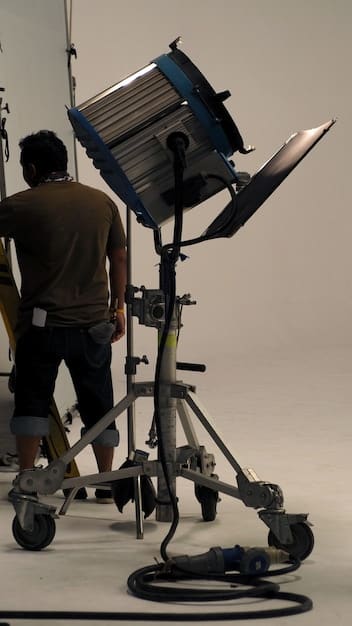
Thorough preparation is crucial to the successful use of locations.
- Secure Permissions: Always obtain necessary permits and agreements.
- Plan Logistics: Address parking, power, and waste management in advance.
- Communicate Clearly: Keep all parties informed about the project’s scope and schedule.
Successful location scouting and management can transform ordinary settings into compelling backdrops that enhance the film’s overall impact.
Set Design and Decoration: Maximizing Impact
Set design and dressing can significantly influence the mood, authenticity, and visual appeal of a short film. Even on a tight budget, strategic choices can create a compelling on-screen environment.
The goal is to transform a space into a believable setting that supports the story and captures the audience’s imagination.
Creating Atmosphere Through Detail
Pay attention to details that add depth and realism to the set. This might include selecting appropriate furniture, hanging artwork, or adding personal touches that reflect the characters’ personalities.
Consider the color palette, lighting, and textures to evoke specific emotions and reinforce the film’s themes. Even small details can make a big difference in creating a immersive experience for the viewer.
DIY and Budget-Friendly Techniques
Embrace DIY techniques to create unique and cost-effective set decorations. This might involve repurposing old items, crafting custom props, or using paint and fabric to transform existing furniture.
Get creative with lighting by using inexpensive sources and experimenting with different angles and intensities. Collaborate with other filmmakers or community members to share resources and expertise.
Transforming a space can be done with smart choices and a creative approach.
- Layering Details: Incorporate details that add depth and realism to the set.
- Budget Creativity: Employ DIY techniques to create unique decorations in a budget.
- Lighting Magic: Use inexpensive light sources to experiment with angles and intensity.
Effective set design and decoration is about meticulously crafting an environment that supports the story and captures the audience’s imagination, making the viewing experience feel authentic and engaging.
Prop Selection and Management for Short Film Shoots
Props are more than just objects; they are extensions of the characters and essential elements in storytelling. Choosing the right props can add depth and authenticity to a short film.
Thoughtful prop selection can communicate key information about characters, setting, and plot, even without dialogue.
Sourcing the Right Items
Start by creating a detailed prop list based on the script. Consider the time period, setting, and characters’ backgrounds when sourcing items.
Explore a variety of sources, including thrift stores, antique shops, online marketplaces, and personal collections. Don’t be afraid to ask friends, family, and community members for help in locating specific items.
Prop Management On Set
Develop a system for organizing and tracking props during the shoot. Assign a designated prop master to oversee the inventory and ensure that items are properly stored and handled.
Create backups for essential props and establish protocols for handling delicate or valuable items. Communicate clearly with the cast and crew about the proper use of props to avoid damage or loss.
Careful planning and management can enhance the storytelling process.
- Detail is Key: Careful prop selection can communicate setting, character, and plot.
- Tracking Props: Manage and organize props to maximize efficiency on set.
- Delegate Authority: Assign a dedicated prop master to oversee and manage the inventory.
The right props, handled with care, can add a layer of believability to the story, deepening the audience’s connection with the film.
Costume Design and Wardrobe Choices on a Shoestring Budget
Costume design plays a crucial role in defining characters and establishing the tone of a short film. Even with a limited budget, thoughtful wardrobe choices can convey important details about the characters’ personalities and backgrounds.
Carefully selected costumes can enhance the visual storytelling and create a cohesive look for the film.
Character-Driven Wardrobe Selection
Start by analyzing the script and identifying key characteristics of each character. Consider their social status, occupation, and personal style when selecting wardrobe items.
Look for clothing that reflects the characters’ inner states and contributes to the overall narrative. Don’t be afraid to mix and match items to create unique and authentic looks.
Smart Sourcing and Alterations
Explore budget-friendly options for sourcing costumes, such as thrift stores, consignment shops, and online marketplaces. Consider borrowing or renting items to save money.
Learn basic sewing and alteration techniques to customize clothing and ensure a perfect fit. Pay attention to details such as accessories, footwear, and hairstyles to complete the overall look.
Proper sourcing and planning yields effective costumes.
- Know the character: Select wardrobe items based on character and narrative analysis.
- Be resourceful: Borrow, rent, or mix and match for a unique look.
- Perfect the details: Ensure accessories, shoes, and hairstyles complete the scene.
Good costume design creates a visually engaging experience for the audience, enriching the storytelling process on all levels.
Lighting and Cinematography: Creating Visual Magic
Lighting and cinematography work together to create visual magic on screen. Even with limited resources, creative lighting techniques can transform a scene and evoke specific emotions.
Thoughtful cinematography enhances the visual storytelling and captures the essence of the film.
Low-Budget Lighting Techniques
Experiment with natural light by shooting during optimal times of day and utilizing reflectors to bounce light into shadows. Use inexpensive lighting fixtures, such as clamp lights and LED panels, to create dramatic effects.
Explore creative lighting gels and filters to add color and depth to the scene. Don’t be afraid to play with shadows and silhouettes to create visual interest.
Cinematic Composition and Framing
Pay attention to composition and framing to guide the viewer’s eye and convey specific emotions. Experiment with different camera angles, focal lengths, and depths of field to create compelling shots.
Use movement to add energy and dynamism to the scene. Consider the overall visual style of the film and strive for consistency in lighting and cinematography.
Transforming the ordinary into the magical is the goal of lighting and cinematography.
- Explore natural Light: Plan shooting times and use reflectors to expand options.
- Creative Composition: Plan shots with emotion with different angles, focus, and depth.
- Consistent Visuals: Aim for consistent lighting and cinematography in short films.
Effective lighting and cinematography can elevate the film’s visual style, creating an immersive and engaging experience for the audience.
Post-Production Enhancements: Refining the Visuals
Post-production offers opportunities to refine the visual aspects of a short film and enhance its overall impact. Color correction, visual effects, and sound design can polish the final product and create a cohesive viewing experience.
The goal is to transform the footage into a polished and professional-looking film that captivates the audience.
Color Correction and Grading
Use color correction software to adjust the colors and tones of the footage, creating a consistent and visually appealing look. Experiment with color grading to evoke specific moods and enhance the film’s themes.
Pay attention to details such as skin tones, contrast, and saturation to create a polished and professional appearance.
Adding Visual Effects
Explore visual effects to add elements that would be impossible or impractical to capture during the shoot. Use software to digitally enhance settings.
Ensure that the effects are seamless and believable, and integrate them organically into the scene.
- Color Correction: Use software in post-production to correct tones and color.
- Add Visual Effects: Enhance the film by digitally integrating effects.
Skilled execution creates an immersive viewing experience for the audience that makes a big impact.
| Key Element | Brief Description |
|---|---|
| 🎬 Production Design | Crafting the visual world to enhance storytelling in short films. |
| 📍 Location Scouting | Finding and managing suitable locations that support the film’s narrative. |
| 🎭 Costume Design | Thoughtful selection of wardrobe to define characters and set the tone. |
| 💡 Lighting & Cinematography | Using light and camera work to create visual magic on a tight budget. |
Frequently Asked Questions
The main goal is to create a believable and immersive visual world that enhances the storytelling, supports the narrative, and evokes the desired emotions, even with limited resources.
Look for locations that align with your script’s requirements and offer the most production value for the cost. Contact local film commissions or community organizations for leads on free or low-cost locations.
Repurpose old items, craft custom props, or use paint and fabric to transform existing furniture. Collaborate with other filmmakers or community members to share resources and expertise.
Analyze the script to identify the characters’ social status, occupation, and personal style. Explore thrift stores, consignment shops, and online marketplaces for budget-friendly options.
Use color correction software to adjust the colors and tone to enhance visual appeal. Explore visual effects to add impossible or impractical elements. Make effects seamless and believable.
Conclusion
Mastering short film production design: creating believable worlds on a small scale in the US, is about using your artistic vision and ingenuity within your financial limitations to create a memorable cinematic experience. By focusing on pre-production planning, location scouting, set design, prop management, wardrobe choices, lighting, cinematography, and skillful post-production enhancements, any filmmaker can craft impactful short films that resonate with audiences.
